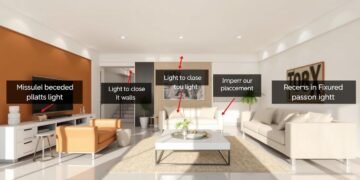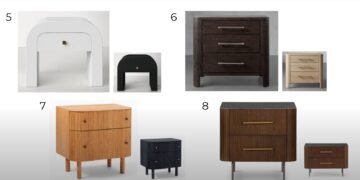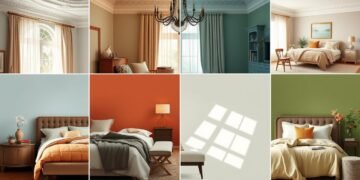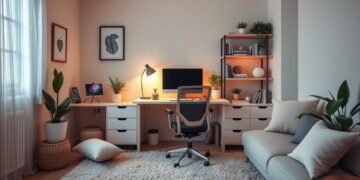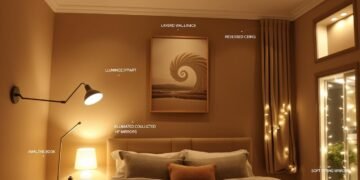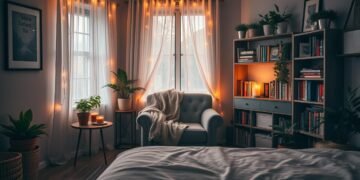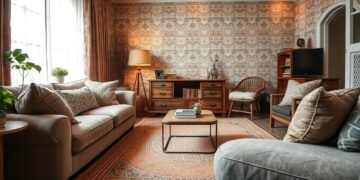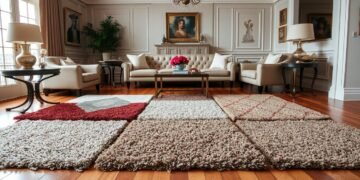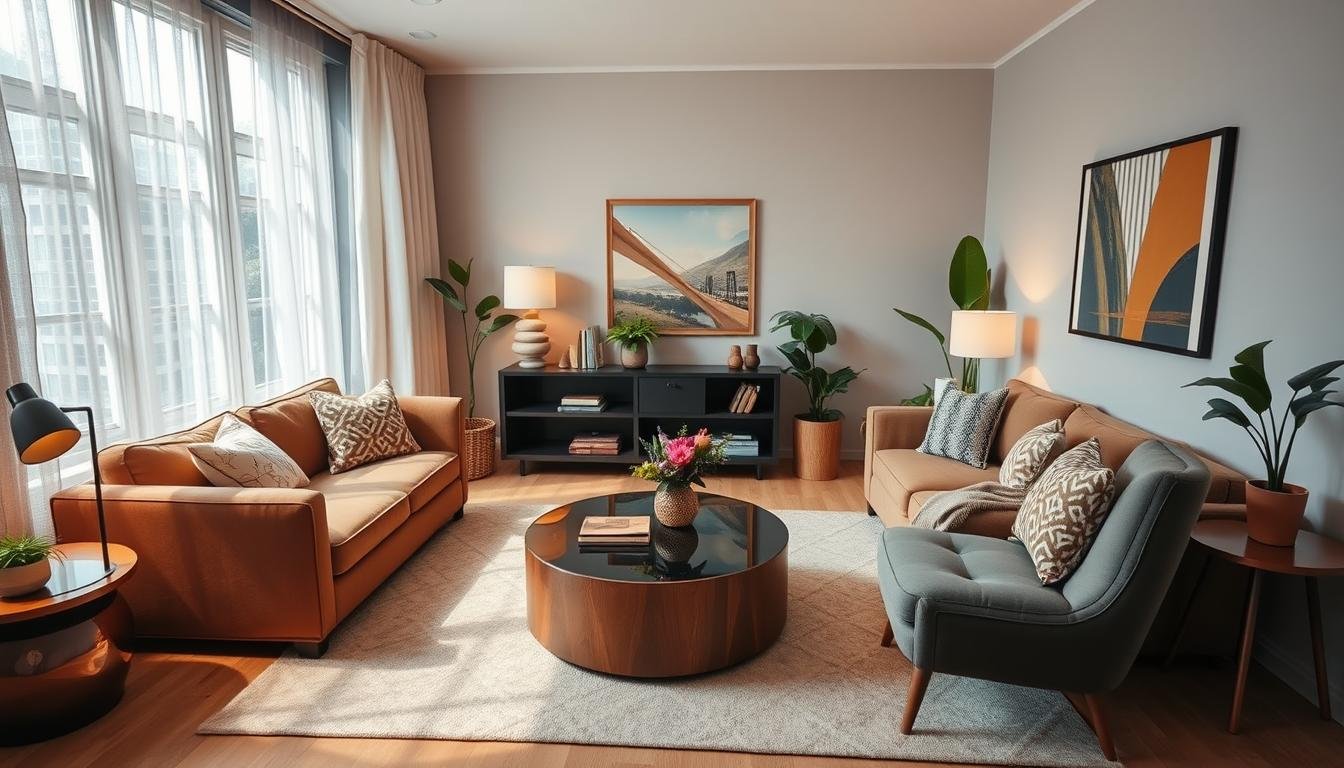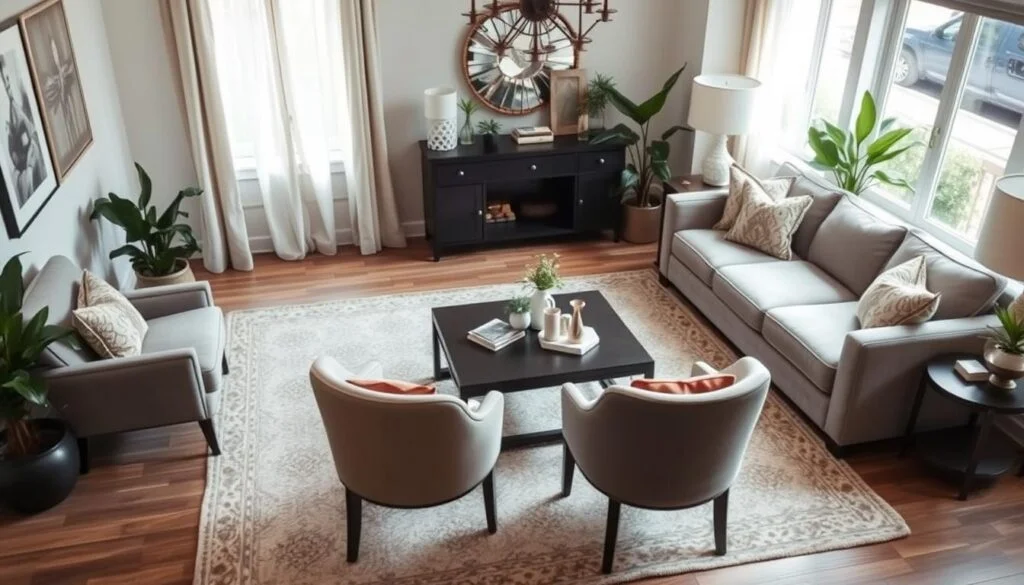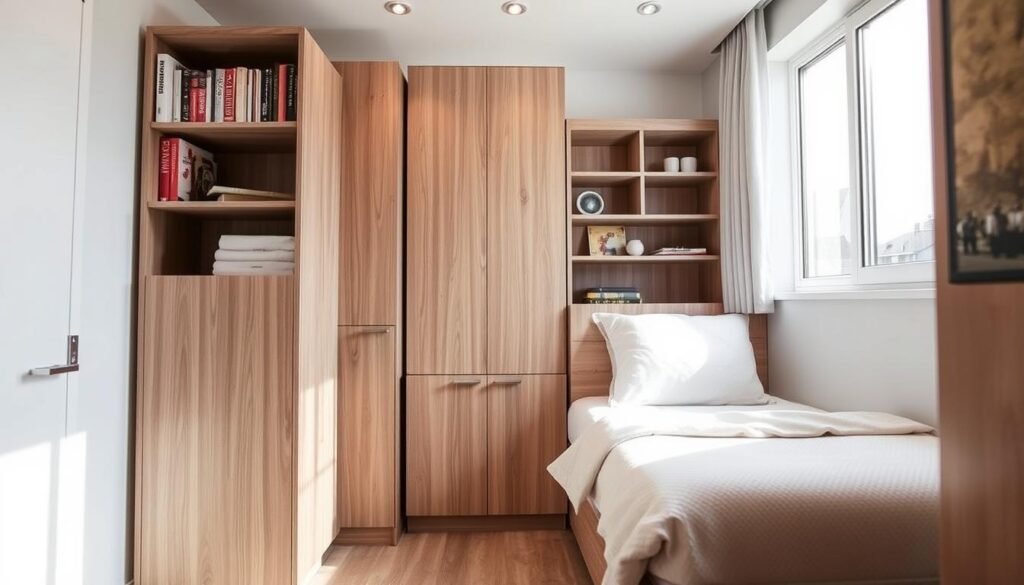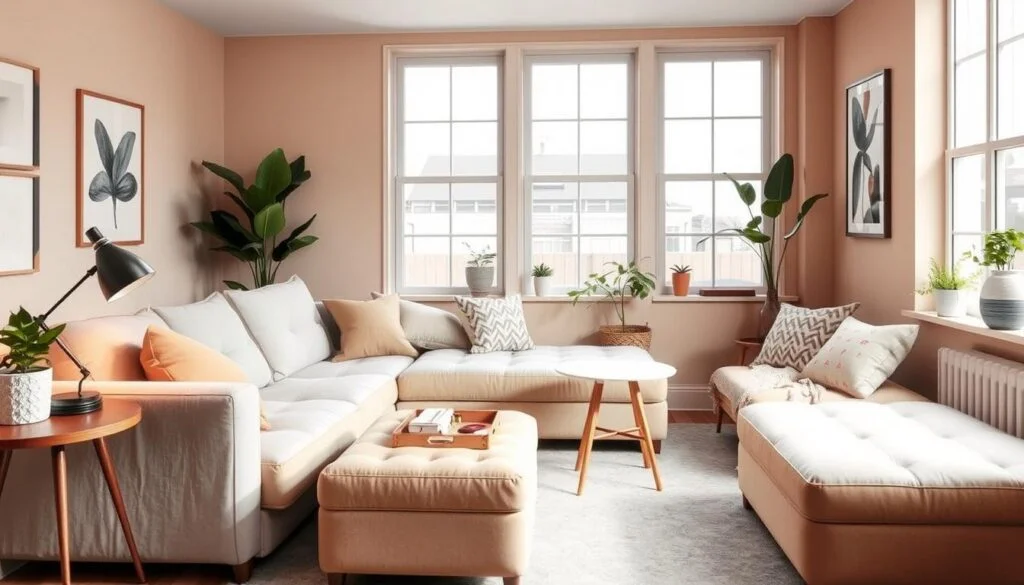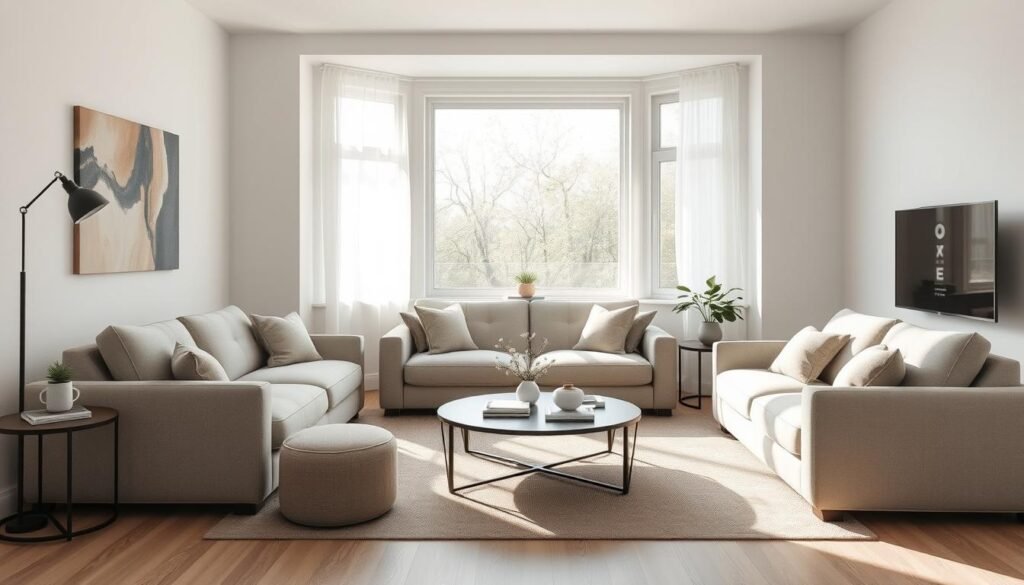Did you know over 1,500 hours of design research have focused on furniture in small spaces? Using big furniture in small rooms can make your space feel bigger and more welcoming.
Choosing furniture for small rooms needs careful planning. It’s not just about size. It’s about making the space look balanced and useful. Designers have found ways to make small areas look big and stylish.
Getting furniture right can change how a room feels. By picking and placing big furniture smartly, you can make a room seem bigger than it is.
Managing room size well lets you use big furniture without losing comfort. Small rooms offer big design possibilities. They need creative ideas and the right furniture choices.
Table of Contents
- 1 Understanding Scale and Proportion in Small Space Design
- 2 Creating Optimal Traffic Flow with Large Furniture
- 3 Strategic Placement of Large-Scale Furniture in Small Rooms
- 4 Maximizing Vertical Space with Tall Furniture
- 5 Using Light and Reflection to Balance Large Pieces
- 6 Selecting Multi-Functional Large Furniture
- 7 The Role of Negative Space Around Large Furniture
- 8 Design Tricks to Make Large Furniture Work
- 9 Common Mistakes When Using Large-Scale Furniture in Small Rooms
- 10 Conclusion
- 11 FAQ
- 11.1 How can I make a small room feel larger when using large-scale furniture?
- 11.2 What’s the ideal furniture placement for small living rooms?
- 11.3 Can I use large furniture in a small room without overwhelming the space?
- 11.4 How do I choose the right size furniture for a small room?
- 11.5 What are the biggest mistakes to avoid when furnishing a small room?
- 11.6 How can I create the illusion of more space with furniture and decor?
- 11.7 Is it possible to use a large sectional in a small living room?
- 11.8 How much space should I leave between furniture pieces?
Key Takeaways
- Large furniture can make small rooms feel more spacious when positioned correctly
- Strategic placement is more important than furniture size
- Focus on creating visual balance and functional flow
- Use multi-functional furniture to maximize limited space
- Experiment with furniture angles to create dynamic room layouts
Understanding Scale and Proportion in Small Space Design
Designing small spaces needs a careful look at furniture size and scale. It’s not just about picking pieces that fit. It’s about how they look and feel together to change your space.
In small rooms, proportion is key. The right furniture-to-room ratio is essential for both looks and function.
Visual Weight vs. Physical Size
Furniture doesn’t affect rooms the same way. Visual weight is influenced by:
- Color intensity and darkness
- Solid vs. leggy furniture designs
- Material transparency
- Furniture silhouette
“In design, scale is about creating harmony, not just filling space.”
The Impact of Furniture Proportions
Using minimalist furniture can really help small spaces. Here are some tips for furniture proportions:
- Go for pieces with raised legs to make rooms feel bigger
- Choose lighter colors
- Use tall elements to lift your gaze
Room Dimensions and Space Planning Basics
| Room Size | Recommended Furniture Scale | Design Strategy |
|---|---|---|
| Small (100-200 sq ft) | Compact, multi-functional pieces | Maximize vertical space |
| Medium (200-400 sq ft) | Balanced proportions | Create visual zones |
| Large (400+ sq ft) | Larger statement pieces | Distribute visual weight |
Getting design balance means seeing how each piece adds to the room’s look. Aim for a space that feels planned, cozy, and looks good together.
Creating Optimal Traffic Flow with Large Furniture
Maximizing small spaces means placing furniture in a way that changes how you move and feel in a room. It’s not just about setting up pieces. It’s about making movement smooth and natural.
When using big sofas and armchairs, room zoning is key. Experts say to pull furniture off walls. This creates lively spots for talking and boosts how we see the room.
“The key to excellent room design is making furniture work for you, not against you.” – Kaiko Design Interiors
- Create clear pathways around furniture clusters
- Use sectional sofas to define distinct living zones
- Consider human scale when selecting furniture pieces
- Maintain breathing room between furniture elements
Smart furniture setup can make tight spaces feel bigger. Knowing how furniture moves and interacts helps design rooms that are both useful and welcoming.
| Furniture Placement Strategy | Impact on Room Flow |
|---|---|
| Pull furniture from walls | Increases perceived space |
| Use pairs of armchairs | Creates visual balance |
| Define conversation core | Enhances social interaction |
Remember: Great design isn’t about filling space—it’s about creating meaningful connections between furniture, people, and environment.
Strategic Placement of Large-Scale Furniture in Small Rooms
Designing a small room with big furniture needs careful planning. The goal is to make the space both useful and beautiful.
Establishing Focal Points
Every room needs a main attraction that catches the eye. In small rooms, this could be a beautiful window, a fancy fireplace, or a standout piece of art. Your big sofas or multipurpose furniture should enhance, not clash with, this focal point.
- Position primary furniture to highlight the room’s natural focal point
- Ensure clear sightlines to the central design element
- Use large pieces to create visual interest without overwhelming the space
Wall Placement Techniques
Smart wall placement is key to using space well. Pull furniture a bit from walls to make the room seem deeper. This trick works great with storage furniture that adds function and visual space.
| Furniture Type | Recommended Wall Distance | Visual Impact |
|---|---|---|
| Sectional Sofas | 3-5 inches from wall | Creates sense of spaciousness |
| Side Tables | 2-3 inches from sofa arm | Ensures convenient accessibility |
Creating Conversation Areas
Make your small room welcoming by setting up chat areas. Arrange seats to encourage talking, keeping furniture far enough apart. Aim to keep 3.5 to 10 feet between seating to facilitate natural communication.
“In small spaces, every inch counts. Strategic furniture placement can transform a cramped room into an elegant, functional haven.” – Interior Design Expert
By using these strategies, you can fit big furniture in small rooms. This keeps the space open and stylish.
Maximizing Vertical Space with Tall Furniture
When designing small living rooms, vertical space is key. It helps create spaces that look bigger and work better. Choosing the right furniture height and size is important.
Tall, narrow furniture is a great space-saving idea. These pieces can change how a small room looks and works.
- Install floor-to-ceiling shelving units
- Use ladder-style bookcases
- Select furniture with visible legs
- Incorporate tall, slim storage solutions
“Vertical design is not about filling space, but creating the illusion of expansiveness.” – Interior Design Expert
Furniture that goes up can make a small room look better. Tall, slim pieces add interest and keep the room feeling open. Here are some tips:
- Hang curtains closer to the ceiling
- Choose multi-functional tall furniture
- Use vertical artwork to enhance height perception
| Furniture Type | Vertical Space Impact |
|---|---|
| Tall Bookshelf | Maximizes Storage, Creates Visual Height |
| Slim Floor Lamp | Adds Vertical Interest, Provides Lighting |
| Wall-Mounted Shelves | Frees Floor Space, Increases Storage |
Remember, in small spaces, thinking vertically is not just design—it’s a strategic approach to living comfortably and stylishly.
Using Light and Reflection to Balance Large Pieces
Decorating with big furniture in small spaces needs smart thinking about light and how we see things. The right strategy can turn a tight room into a big, welcoming space.
Reflective surfaces are key to making a room look bigger. In fact, 90% of small or awkward rooms have uneven heights and lack balance.
Mirror Placement Strategies
- Place bigger mirrors to add depth and boost natural light
- Use mirrors smartly to make furniture look more in scale
- Put mirrors opposite windows to double the room’s look
Bigger mirrors are better at adding interest to small walls than smaller ones. They make a room look bigger and improve comfort in tight spaces.
Lighting Techniques
Lighting is essential for making a room look wider. Here are some lighting tips:
- Use wall lights to improve visual balance
- Set up layered lighting with different sources
- Choose sheer window treatments to let in more natural light
Color Selection for Visual Space
| Color Strategy | Visual Impact |
|---|---|
| Light wall colors | Makes the room feel airy and big |
| Warm neutral tones | Adds depth without feeling too much |
| Subtle color contrasts | Gives the room visual depth |
“Maximizing vertical space is not about shrinking furniture, but about creating intelligent visual landscapes.”
By carefully using light, reflection, and color, you can change small spaces into lively, appealing areas. They can feel both open and cozy at the same time.
Selecting Multi-Functional Large Furniture
When furnishing small apartments, it’s key to place furniture wisely. This creates a space that looks bigger. Multi-functional furniture is a smart choice. It makes the most of the room while looking good.
More people are choosing furniture that does more than one thing. These smart designs fit well in small spaces. They help balance the room without making it feel cramped.
“The key to small space design is not about reducing furniture, but selecting pieces that work harder and smarter.”
Top Multi-Functional Furniture Options
- Storage ottomans with lift-up lids
- Convertible sofas with hidden bedding
- Nesting tables that stack when not in use
- Wall-mounted desks that fold away
- Benches with internal storage compartments
Space-Saving Furniture Strategies
| Furniture Type | Space-Saving Feature | Utility |
|---|---|---|
| Modular Sectional Sofa | Configurable Pieces | Adaptable Seating |
| Murphy Bed | Vertical Storage | Bedroom/Office Conversion |
| Expandable Dining Table | Compact Design | Flexible Dining Options |
Choosing furniture with lightweight visual profiles and built-in storage can change small spaces. It turns them into stylish, functional areas. The right furniture can make a room feel bigger and more useful.
Remember, it’s not about less furniture in small rooms. It’s about using design to make the most of the space.
The Role of Negative Space Around Large Furniture
Designing for small spaces means using furniture wisely and knowing the space well. Negative space is key to making rooms feel bigger and more welcoming.
Choosing furniture for small rooms is not just about picking pieces. It’s also about leaving space open. Designers say that negative space gives rooms a visual break, making them less crowded and less stressful.
Balance and Breathing Room
When designing for small spaces, keep these spacing tips in mind:
- Maintain 30-36 inches of walkway between large furniture pieces
- Keep 16-18 inches between sofas and coffee tables
- Allow 42 inches between accent chairs
Creating Visual Flow
Space planning mistakes happen when rooms feel too tight. Transparent and minimalist furniture can make rooms seem larger. This helps create a sense of openness and flow.
Negative space is not emptiness—it’s a deliberate design element that gives your eyes a place to rest and your body room to move.
Space Between Pieces
Strategic spacing can change how a room feels. By thinking about the space between furniture, you add depth and avoid visual clutter.
- Use lighter-colored furniture to enhance the perception of space
- Select pieces with legs to create visual breathing room
- Avoid overcrowding with excessive decorative items
Design Tricks to Make Large Furniture Work
Designing small rooms with big furniture needs smart planning and creative ideas. You want your space to feel big and thoughtful, even when it’s small.
Here are some tips from experts on fitting big furniture in tight spaces:
- Choose furniture with lightweight visual profiles – pieces with exposed legs create an airy feeling
- Select lighter color palettes to expand perceived space
- Opt for multipurpose furniture that serves dual functions
Visual tricks can change how your room looks. Try platform beds, low-slung chairs, and slim furniture to keep it open. Glass or lucite pieces make rooms seem bigger.
“The right furniture can make a small space feel expansive and purposeful.” – Interior Design Experts
Where you place furniture is key. Pull it away from walls, use rugs to anchor, and make clear zones in small areas.
- Use mirrors to reflect light and create depth
- Incorporate vertical storage solutions
- Select compact versions of statement furniture pieces
Good small room design isn’t about getting rid of big furniture. It’s about using it wisely and keeping things balanced.
Common Mistakes When Using Large-Scale Furniture in Small Rooms
Choosing the right large-scale furniture for small rooms can be tough. Many homeowners find it hard to make their space balanced and functional. They often feel overwhelmed by their furniture choices.
“Space is a precious commodity in small rooms, and every design decision matters.” – Interior Design Expert
When making large furniture work in compact spaces, avoid these critical mistakes:
- Pushing all furniture against walls, creating a rigid and uninviting layout
- Overcrowding the room with multiple small pieces
- Blocking natural light sources with bulky furniture
- Ignoring proper spacing between furniture pieces
Space-saving furniture for small rooms needs smart placement and thought. Experts say to keep furniture at certain distances for the best flow:
| Furniture Placement | Recommended Distance |
|---|---|
| Walkway Space | 30″ to 36″ |
| Sofa to Wall Placement | 3-5″ pulled forward |
| Sofa to Coffee Table | 16″ to 18″ |
| Between Seating Areas | 3.5′ to 10′ |
Pro tip: Balance is key when incorporating large furniture in small spaces. Focus on creating visual breathing room and maintaining proportional relationships between pieces.
Remember, scale is important in room design. Low-profile furniture is best for rooms with lower ceilings. Taller pieces can add drama to spaces with higher ceilings.
- Use vertical elements to create visual interest
- Select furniture that serves multiple functions
- Leave some areas open for better traffic flow
By avoiding these common pitfalls and understanding spatial relationships, you can turn a small room into a beautifully designed, functional space. It will feel spacious and inviting.
Conclusion
Creating a balance with large furniture in small spaces is an art. It needs careful thought and creative ideas. In cities, finding ways to fit big furniture in small rooms is key.
Big sofas can be a highlight in small living rooms if done right. It’s not about cutting down your style, but finding ways to make the most of the space. Pieces like sofa beds and storage sofas are great for making rooms flexible.
Success in design comes from knowing how to use space well. Using light colors, smart placement, and clever storage can make small areas look bigger. Styles like mid-century modern and Scandinavian are perfect for creating open and elegant spaces.
Designing for small spaces means making smart choices. Choose quality over quantity, use vertical space, and pick furniture that does more than one thing. This way, you can make a space that’s both cozy and stylish. It’s about finding ways to fit furniture well in small areas, not sacrificing style.







